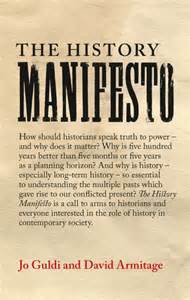Jo Guldi and David Armitage. The History Manifesto. Cambridge: Cambridge University Press, 2014. 165 pages.
The full text of the book is freely available here, as an Open Access publication.
Review by Scott Richard St. Louis
“A spectre is haunting our time: the spectre of the short term.”
This proclamation stands tall as the first sentence of The History Manifesto, a new and thought-provoking title published late last year as the first open-access monograph ever offered by Cambridge University Press. Guldi and Armitage provide their readers with a vivid portrait of a world plagued both by deeply historical problems and by short-term thinking in political, corporate, and even academic circles (1-8), represented well in their statement of concern: “Who is trained to wait steadily upon these vibrations of deeper time and then translate them for others?” (5). After posing this vital question, Guldi and Armitage answer it with their thesis statement: “Our argument is that History – the discipline and its subject-matter – can be just the arbiter we need at this critical time” (7).
On the whole, this book raises timely and important concerns about the public profile of historians in the world today. Within its pages, Guldi and Armitage venture a response to the malaise that often accompanies conversations about the present-day influence of historical scholarship on decisions made by the powerful. For this reason, the book is itself an artifact of interest to intellectual historians, especially those seeking to contextualize and interpret contemporary historiographical trends. Unfortunately, the potential impact of The History Manifesto has been severely limited from its release, due to a conspicuous and embarrassing irony contained within its pages. Though Guldi and Armitage argue that historians can inform policy debates by becoming publicly engaged “arbiters of big data” (12), they fail to perform competently even the most rudimentary quantitative data analysis, especially in the historiographical arguments of the second chapter.
After stating their bold thesis about the potential future of the historical profession, Guldi and Armitage are careful to inform readers that they are not hopelessly striving to push historians in a single direction, but instead are offering their commentary on a trend that is already underway: “[T]here is now an expanding universe of historical horizons, from the ‘deep history’ of the human past … to ‘big history’ going back to the Big Bang … The return of the longue durée is how we describe the extension of historians’ time-scales we both diagnose and recommend in this book” (8-9). Going further, Guldi and Armitage argue that this trend has lent new “responsibility” and “urgency” to the work of historians in the twenty-first century, as questions abound about the consequences of human actions over the course of centuries and millennia, especially with regard to the issues of climate change, international governance, and inequality (9).
Following an introductory section in which Guldi and Armitage lay out the ambitious scope of their work, the first chapter situates their illustration of a revived longue durée in its historiographical context, first by discussing the work of French historian Fernand Braudel and the Annales group (pp. 15-18). They offer a concise explanation of Braudel’s “intersecting but not exclusive temporalities that structured all human history” including histories of humans in their physical environment, histories of state and society, and histories of noteworthy events (16).
While contextualizing Braudel and the longue durée of the Annales group, Guldi and Armitage assert that the mid-twentieth century was, on “both sides of the Atlantic,” a time during which “the future was as much an object of interest as the past and, indeed, the prospects for the two … were tightly connected to one another” (18). In so doing, they link Braudel to an older tradition of “historical orientation towards practical action and the future” (19). The lineage of this tradition, they argue, dates back to Thucydides, but was also reflected in the work of such “counsellor-historians” as Niccolò Machiavelli, leading nineteenth-century politicians in Britain and France, and such “[r]eformers and revolutionaries” as Karl Marx, Sidney and Beatrice Webb, and Lewis Mumford (19-26). Guldi and Armitage conclude by discussing three ways in which the aforementioned  historians showed that thinking about the past can promote discussion about the future: “Thinking About Destiny and Free Will” (30-31), “Counterfactual Thinking” (31-34), and even “Utopian Thinking” (34-35). They argue that such thinking will prove vital for historians of a revived longue durée, working in an “engaged academia” with a renewed “ethical purpose” as they write “histories of climate and inequality … in terms of a comprehensible knowledge grounded in data and described by overlapping flows of materiality, construct, and cause” (36-37).
historians showed that thinking about the past can promote discussion about the future: “Thinking About Destiny and Free Will” (30-31), “Counterfactual Thinking” (31-34), and even “Utopian Thinking” (34-35). They argue that such thinking will prove vital for historians of a revived longue durée, working in an “engaged academia” with a renewed “ethical purpose” as they write “histories of climate and inequality … in terms of a comprehensible knowledge grounded in data and described by overlapping flows of materiality, construct, and cause” (36-37).
Following a brave first chapter, Guldi and Armitage falter with a poorly substantiated argument about when works of practical, future-oriented history over the longue durée began to fall out of favor relative to micro-historical research emphasizing highly focused questions and the “mastery of discrete archives” (42). Guldi and Armitage claim that such a development took place with “historians who came of age around 1968,” a generation determined to employ new methodologies “in order to contexualise enormous forces like racism or nationalism as constructed developments” (40). Sadly, the data they provide to support this argument clearly contradicts it. Indeed, their first graph indicates that the mean length of time covered in history dissertations in the U.S. began to decline early in the twentieth century, plateaued for several decades, dipped slightly in the 1960s, and began to move steadily back upward by 1970 (44). Additionally, a Google N-gram Viewer graph indicates that use of the term “more and more about less” – common in lamentations about overspecialization – peaked in the 1940s (49), a finding at odds with complaints about overspecialization made in the 1980s (mentioned approvingly on page 53). Unfortunately, the errors that Guldi and Armitage make in their second chapter have a devastating effect on their work as a whole, considering their vision of a future where academic historians will “provide data analysis for legislative committees, advise activist campaigns, or consult with Silicon Valley startups” (114). Most historians can agree that the world would indeed be a better place if politicians, activists, and entrepreneurs demonstrated a greater interest in their connection to the past, but the faulty analysis presented by Guldi and Armitage in their second chapter suggests dishearteningly (and untruthfully) that the leaders of such organizations would do better to avoid historians than to consult them. This is a perception that Guldi and Armitage rightfully want to change, but their second chapter does more to perpetuate this unfortunate view than to combat it.
The third chapter of the work explores three contemporary issues that inspire questions of long-term thought, including climate change (64-73), international governance (73-79), and inequality (79-81). Guldi and Armitage insist that historical thinking, recognizing the ever-present myriad of “possibilities and alternative models” (68), would serve as a strong counterbalance to the universal models of climate scientists and economists. Indeed, economists on the whole do not receive a flattering illustration in this book. Even so, Guldi and Armitage fail to consider the irony of their words when they praise Capital in the Twenty-First Century by Thomas Piketty as an example of “longue-durée analysis [which] shook the prejudices and supposed laws of economists” (80). Considering that their portrayal of economists is often contradictory and excessively simple, Guldi and Armitage find better support for their argument by sticking to the discipline they know best. Their arguments feel more coherent when Guldi and Armitage credit the work of historians Theodore Porter and Ian Hacking as having employed the critical data analysis that they endorse, in this instance revealing that such government statistics as “unemployment” were often calculated “with a view of establishing political peace by minimising the case of the working class for reparations, welfare, or even government reform” (80).
The fourth chapter of the Manifesto provides a fascinating discussion of new tools that utilize vast troves of big data to facilitate the production of scholarship with an eye to the new longue durée. Foremost in this discussion is Guldi’s own Paper Machines, which makes “state-of-the-art text mining accessible to scholars across a variety of disciplines in the humanities and social sciences” (90). Guldi and Armitage find that “[r]ich information can help to illuminate the deliberate silences in the archive, shining the light onto parts of the government that some would rather the public not see” (100). In this way, big data can empower scholars of the revived longue durée to promote accountability, social justice, and transparency, as historical research employing shorter timespans has done for decades.
Strengths and flaws considered together, The History Manifesto is a worthwhile read as a single piece of the broad and historiographically significant controversy which it has generated. Moreover, a recent article in The Chronicle of Higher Education finds that the book has served as a catalyst for much-needed debates about accountability and digital scholarship in the historical community. That discussions about the book ought to continue is clear when one finds questionable claims even in the most detailed critiques of the Manifesto. For example, an impassioned exchange between the authors and two of their most vociferous critics, Deborah Cohen and Peter Mandler, was published in the April 2015 issue of the American Historical Review. Cohen and Mandler rightly draw vital attention to the bad data analysis of the book (532-534), but they also insist unfairly that the Manifesto’s support for reclaiming the public status that history once enjoyed is somehow elitist (537). In so doing, Cohen and Mandler ignore the fact the Manifesto’s open-access publication is itself a statement against the elitist tendencies of an academic publishing system that places strains on even the wealthiest institutions of higher learning in the world. Additionally, their claim lumps the different populations that Guldi and Armitage hope historians will better engage in the future – activists, politicians, and CEOs alike – into an unconventionally defined “elite” that strangely includes policymakers and entrepreneurs alongside the activists who combat political corruption and disparities of wealth.
Guldi and Armitage raise this concern in their response to Cohen and Mandler (546), and in spite of all the problems in their Manifesto, they are right to do so. Surely it is true that using history to bend the ears of the powerful is not synonymous with turning history into a tool that exclusively serves the interests of the elite. Cohen and Mandler’s critique leaves readers with the impression that the two are one and the same. More contributions to this ongoing conversation are therefore necessary, if only to point out the flawed reasoning that has informed advocates and detractors of the Manifesto alike. For this reason, historians from every corner of the diverse profession should read the call to action that Guldi and Armitage have put forth, alongside positive and negative responses to it. Criticizing their work, while necessary, is much easier than offering more rigorous answers than theirs to questions about the status of history in the halls of power and in public life more broadly.
Scott Richard St. Louis is a student of history, political science, and French in the Frederik Meijer Honors College at Grand Valley State University. His scholarly interests include archives, historiography, public history, digital humanities, and the Open Access movement.


0